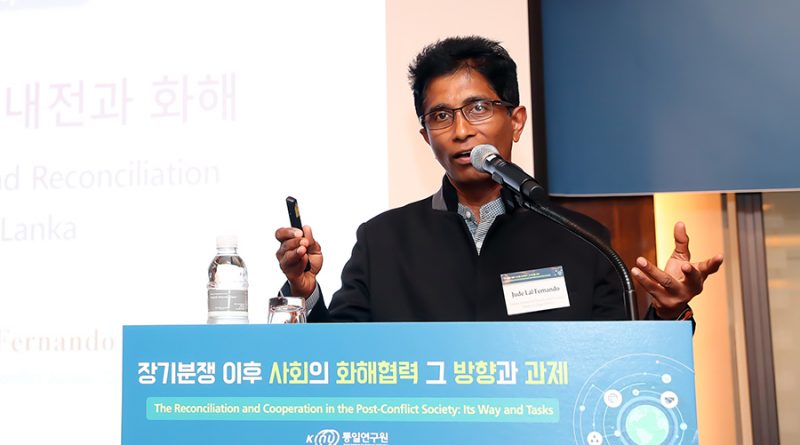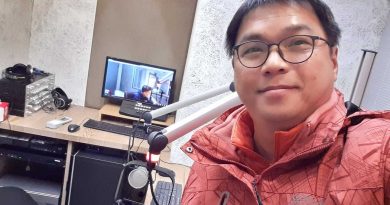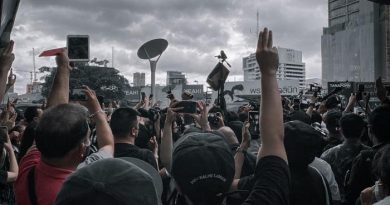NCCK Interview with Professor Jude Lal Fernando
Jude Lal Fernando is a professor in Trinity College Dublin, who lives in exile in Ireland for the last 15 years because of his opposition to the war against the Tamils and ongoing human rights violations in Sri Lanka, and his support for Tamil right to self-determination. He is the editor of the book, Resistance to Empire and Militarization (2020) and the coordinator of Peoples’ Tribunals on Sri Lanka, which were held in Dublin (2010) and Bremen (2013).

Shin: You have worked for more than 20 years for a peaceful political settlement to the national conflict in Sri Lanka before you left the country to Ireland in 2004. You opposed the war against the Tamils that ended in 2009 with a massive loss of lives. What exactly is the conflict between the Sinhalese and the Tamils in Sri Lanka?
JLF: The Sri Lankan state, even though it officially claims to represent all the citizens of the country (both the Sinhalese and Tamils), is a Sinhala state that has discriminated against the Tamils since the very establishment of that state. Who established this state and what kind of a state it is? In fact, it is the British Empire, which built one single state for the whole island by merging Sinhala and Tamil regions into one unitary political structure as far back as 1833. Before the colonial period these two regions were autonomous from one another. Of course there were overlapping histories, identities and shared sovereignty with each other, but not a single state structure with racial divisions. What the British did in Sri Lanka is similar what the Meiji Empire did by annexing Ryukyu Islands into the mainland Japan. The empires did this for strategic reasons.
In the case of the Korean peninsula the imperial powers divided the nation by supporting one side against the other. A similar division was done in Ireland where the British Empire held on to power in the northern part while the southern part gained independence. In all these cases, we find structures of division forged by the imperial powers in two ways; one by forced unity (Sri Lanka and Japan/Okinawa) and the other by forced division (Korea and Ireland). In Sri Lanka, the British Empire, not only built a unitary political structure for the whole island forcing the Tamils to come under the Sinhala rule, but also projected Sinhalese as racially superior to the Tamils. The Sinhalese who were the numerical majority were made to believe that the entire island belongs to them and the Tamils were invaders from India. The British were colonizing the island, but the Tamils were portrayed as invaders. In fact, the British wanted to separate the island of Sri Lanka—under a single state structure— from India and use Sri Lanka as a strategic location in controlling India. The Tamils in Sri Lanka were closer to the Indian uprisings against the British rule. The British saw them as a threat to the Empire rather than the Sinhalese who asked for only a dominion status under the British. The Sinhala leaders did not ask for full independence like in India.
Even though the island is called the Sri Lankan state it is a Sinhala state that oppresses the Tamils structurally and racially. As the US-backed South Korean regimes developed an anti-communist nationalist ideology against North Korea, the British-made Sri Lankan state or Sinhala state developed an anti-Tamil nationalist ideology and carried out a series of discriminatory measures against the Tamils. This is the background to the conflict.
Shin: So you mean to say that the conflict was there before Sri Lanka gained Independence in 1948? What was the response of the Tamils?
JLF: The foundations for the conflict, an oppressive state and forced unity, were laid during the British colonial period. The conflict that was implicit during the colonial period became explicit after Independence. As you know even though Korea gained Independence from Japan, South Korea remains dependent on the US and the structure of division of the peninsula became rigid after the Korean War in the context of the Cold War. The Sri Lankan state, after Independence—being a dependent state like South Korea— further strengthened its anti-Tamil racial political position. As a matter of fact, long before Independence the British colonial government renovated ancient Buddhist shrines, but not Hindu or Muslim places of worship. In fact, these ancient Buddhist shrines were not strictly Sinhala. Buddhism was a pluralist tradition that had many languages including Tamil, but when the British colonial government renovated these shrines they became strictly Sinhala Buddhist shrines. This not only deprived the Tamils of their ancient cultural heritage, but created cultural and religious divisions between the Tamils and the Sinhalese. Just before Independence in 1948, the British colonial government with the Sinhala nationalist leaders built Sinhala settlements in the Tamils areas. Further such settlements were built immediately after Independence by the first Sri Lankan government. This deprived the Tamils of their land. The citizenship rights of the Tamils who were working in the Tea Plantations in the central hills (who are distinct from the Tamils in the North and East) were removed immediately after Independence. Thousands of them lost all what they had and Tamil representation in the Parliament decreased. Later, Sinhala was made the only official language of the entire country depriving thousands of Tamils of their state and public sector employments. Later in the early 70s Sinhala students were given more chances to enter universities than the Tamil students.
What did the Tamils do? On all these occasions the Tamils protested non-violently between 1950s-1970s, following Mahatma Gandhi’s methods, but these protests were brutally attacked by the Sinhala racist groups with the blessings of the Sri Lankan governments. In addition to these, there were large scale anti-Tamil attacks led by the Sinhala racist gangs with the support of the state security forces with total impunity. In 1981, one of the richest libraries in the Tamil city of Jaffna in the North was brunt down with over 90,000 books by these groups. In July 1983 within a week, over 3000 Tamils were killed and half a million of them got displaced due to widespread attacks on Tamils. During this period the North and East, which is the traditional Tamil homeland, was heavily militarized by the Sri Lankan state depriving the Tamils of their freedom of expression, movement and many other civil liberties. Large numbers of Tamils were arrested, tortured and imprisoned from time to time. It was more than oppression and repression. It was a process of annihilation of Tamils. During this period the Tamils demanded equal rights such as language rights, employment rights, land rights and education rights. They asked for devolution of power to the North and East of the country, but not total separation. But as their protests were brutally crushed and many were killed the resistance moved from a nonviolent mode to an armed mode since the late 1970s and early 1980s. They demanded total independence to the North and East of the island led by the Liberation Tigers of Tamil Eelam (LTTE). The response of the Sri Lankan state was war against the Tamils, which was backed by USA, UK and Israel. Between 1983-2002 at least 60,000 Tamil civilians were killed. Around 2000 Sinhala and Muslim civilians were killed due to counter-violence of the LTTE. Thousands of Sri Lankan soldiers and LTTE members were killed. Over 1.5 million people were displaced as refugees.
Shin: We have heard about the 2002 peace process between the Sri Lankan state and the LTTE? Do you think it could have resolved the conflict? Why did it fail and end up in another war that killed so many people? After such a massacre what are the challenges for peace in Sri Lanka today?
JLF: During the 20 year war in Sri Lanka between 1983-2002 the Tamil national leadership built their own state in the North and East of the island, which is called Tamil Eelam with the people’s power, both local and diaspora. It is like North Korea building its own state under Juje philosophy. The Tamil state was a secular state, not a religious state like the Sinhala Buddhist Sri Lankan state. It was not anti-religious like in France or in the former USSR. It was religiously pluralist and respected the humanist versions of every religion and opposed fundamentalist versions of religions. It had military, political and civic administrations like any other state, but free of corruption and malpractices. It had very progressive social reforms like gender equality. This state was becoming stronger and the Sri Lankan state and its society were becoming weaker even though it was backed by the major powers in the world. The Sri Lankan state lost many areas to the LTTE and lost many of their soldiers. Its economy was becoming weaker. The Sinhala people were becoming tired of war. In 2000 and 2001, the LTTE had declared unilateral ceasefires demanding political negotiations, but the Sri Lankan state continued to wage its war and lost many soldiers. By 2002 due to military balance of power between the two parties there came a ceasefire and a peace process.
Yes, you are right. The 2002 peace process could have brought about a peaceful settlement to the conflict without causing that massive loss of lives in 2007-2009. In fact, it stopped all the deaths and displacement that were happening for 20 years. It was the most significant political moment in the modern history of the country after the British colonized the island. The ceasefire came into effect not because of any external pressure by any power in the world, but simply because of the internal agreement between the two parties. Let us imagine that South Korea and North Korea decide to enter into a peace process without any external influence or not allow any external power to dominate their peace talks. This is exactly what happened in 2002. The year of 2002 was the year when the Sri Lankan unitary political structure was at its weakest point and the Sinhala racist nationalist ideology had no currency. There were 6 rounds of talks between the two parties in Tokyo, Bangkok, Geneva, Berlin and Oslo to negotiate how to attend to burring humanitarian issues of the war-affected people and then share power. This meant shared sovereignty under two governments; LTTE in the North and East and the Sri Lankan state in the South. During this time I was working with many civil society groups to build local support for the peace process. I travelled more than 100 times to the North and East from the South, sometimes with groups of Sinhalese and also organized many meetings for the groups of Tamils to come to the South.
Why did this peace process fail? As soon as the ceasefire agreement was signed the USA got alarmed. It sent 26 high profile naval officers of the Pacific Command to the Trincomalee harbor, which is located in a Tamil area ( still under the control of the Sri Lankan state) to study how to execute the future war. They recommended new weapons to Sri Lanka and new training to the Sri Lankan security forces. The USA also excluded the LTTE from an important meeting of the peace process by holding it in Washington. LTTE was a banned organization in the USA. No neutral venue was considered to hold this meeting despite many appeals made by the civil society groups. Under the USA and UK pressure the EU—which was very supportive of the peace process from the beginning— banned the LTTE in 2006. The USA entered into a defense agreement with the Sri Lankan state in 2007 and 1000 US Marines were sent to Sri Lanka from Okinawa to train the Sri Lankan soldiers in 2007. The Sri Lankan state and the LTTE had agreed to form joint committees to demilitarize, reconstruct and rehabilitee the war-affected regions. Instead of supporting such peaceful political negotiations the USA and UK demanded that the LTTE should lay down arms, but went on arming the Sri Lankan state diplomatically, economically and militarily. This is like asking North Korea to denuclearize without supporting any political negotiations that build confidence between the two parties or supporting the South Korean government with more weapons and training. The peace process was destroyed. People’s aspiration for peace, Sinhala and Tamil including the Muslims, was destroyed primarily, not locally, but by the external powers.
Shin: Why did the external powers do that? What can we do for justice and peace in Sri Lanka?
JLF: These powers wanted to protect the unitary state against the Tamils in increasing their power in the Indian Ocean and encircle China and stop China’s influence in South Asia. India too backed the USA and UK in supporting the Sri Lankan state to wage the war against the Tamils. The LTTE in their peace talks in Tokyo in 2003 stated that they wanted the Indian Ocean to be a peace zone where no power can use it for any war. This is like declaring Jeju and Okinawa islands as peace zones. The Tamil national goal for peace in the Indian Ocean really went against the US pivot towards Asia, which wanted the Sri Lankan unitary state structure to be strong. The biggest obstacle to the US agenda in the Indian Ocean was the Tamil state and their struggle for justice and peace. From 2007-2009 at least 70,000 Tamils were massacred and over half a million people were displaced. The entire Tamil state was destroyed by using maximum firepower. During the war the Sri Lankan national security law did not allow any humanitarian aid to the Tamil region. Racism against the Tamils, which was very weak during the peace process in the Sinhala South, reached its climax during the war because of the support given to the Sri Lankan state by the external powers. Let us imagine anti-communist Christian evangelical groups becoming very powerful in the South Korea and the moves are taken for a unification of Korea by military means with the support of the USA. We cannot even think of such a catastrophe in East Asia, but in South Asia such a disaster has already happened to the Tamils. What we have in Sri Lanka today is a military victory, a victor’s peace. Again the island of Sri Lanka has become the most militarized state in South Asia and Tamils, including the Muslims, are undergoing a severe process of oppression under Sinhala unitary state. International solidarity towards the Tamils and Muslims is necessary like we extend our solidarity towards the Palestinians, Okinawans and many other oppressed peoples across the world. In that solidarity, the Tamil right to self-determination as a nation has to be recognized and their right to remember those who have been killed has to be universally upheld. At the moment such remembrance is suppressed by the Sir Lankan state. It is by increasing solidarity with those who struggle for justice and freedom we can overcome the challenges to peace in Sri Lanka. The Tamil struggle for freedom is deeply connected to peace in South Asia. It should not be seen as an isolated struggle. As the peace movement in Korea and Okinawa are highly important for East Asia the Tamil struggle for justice is significant for peace in South Asia. In fact, these two regions are interconnected when we think of peace in Asia and the world.
Useful Links
People’s Tribunal on Sri Lanka
About ongoing human oppression of the Tamils. www.tamilnet.com
https://www.tamilnet.com/art.html?catid=13&artid=39690
The webiste of the Sinhala journalists who are in exile as a result of their oppostion to war againat the Tamils




